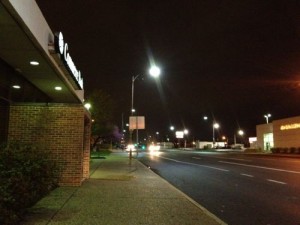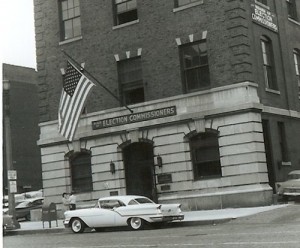Readers Not Concerned About LED Street Lights, But Should Be

In the Sunday Poll a few days ago nearly three-quarters of readers weren’t concerned about health warnings from new LED street lights, here are the results:
Q: St. Louis is replacing old street lights with LED units. How concerned are you about possible negative health effects of unseen blue light from some LEDs?
- Very concerned 3 [8.33%]
- Concerned 3 [8.33%]
- Somewhat concerned 4 [11.11%]
- Neutral 1 [2.78%]
- Somewhat unconcerned 1 [2.78%]
- Unconcerned 15 [41.67%]
- Very unconcerned 9 [25%]
- Unsure/No Answer 0 [0%]
The new lights were tested in 2010.
I’m among the minority that is concerned. We were slow to begin adopting LEDs, which may be a good thing if we learned from cities that made the switch years ago. I’m not so sure we have learned anything from others.
The Department of Energy and the Environmental Protection Agency “put a lot of push into them,” said Michael Siminovitch, director of the California Lighting Technology Center at the University of California at Davis. “I call it a rush.”
Siminovitch said the light from early-generation LEDs “really negatively impacts people’s physiological well-being.”
Lighting is measured by color temperature, which is expressed in “kelvin,” or “K.” The original LED streetlights had temperatures of at least 4000K, which produces a bright white light with a high content of unseen blue light.
Now, LEDs are available with lower kelvin ratings and roughly the same energy efficiency as those with higher ratings. They don’t emit as much potentially harmful blue light, and they produce a softer, amber hue.
White, blue, amber? Kelvin? Okay, it gets technical from this point but I hope I’ve made it understandable to everyone:
Lighting is measured by color temperature, which is expressed in “kelvin,” or “K.” The original LED streetlights had temperatures of at least 4000K, which produces a bright white light with a high content of unseen blue light.
Now, LEDs are available with lower kelvin ratings and roughly the same energy efficiency as those with higher ratings. They don’t emit as much potentially harmful blue light, and they produce a softer, amber hue.
When 4000K and 5000K LEDs were installed, they drew mixed responses. Police and traffic-safety officials and many motorists liked them because they created a bright light that sharply illuminated the ground they covered.
But in many places, including New York City and Seattle, residents complained that the bright white light was harsh, even lurid. People described them as invasive, cold and unflattering. (Washington Post)
To help put this in context, lighting manufacturer Westinghouse explains:
What is color temperature?
- Color temperature is a way to describe the light appearance provided by a light bulb (lamp). It is measured in degrees of Kelvin (K) on a scale from 1,000 to 10,000.
- Typically, commercial and residential lighting application Kelvin temperatures fall somewhere on a scale from 2000K to 6500K.
- A light bulb’s (lamp’s) color temperature lets us know what the look and feel of the light produced will be.
- The color temperature of a light bulb (lamp) is assigned using the basis of correlated color temperature (CCT).
For example, if you heat up a metal object, the object appears to glow. Depending on the Kelvin temperature that the metal object is being heated at, the glow will be various colors, such as orange, yellow or blue. The color temperature of light bulbs (lamps) is meant to replicate the Kelvin temperature of the metal object.What color temperature is right for me?
Understanding Kelvin temperature (K) makes it easier to choose lighting that gives you the look and feel you want.
- At the lower end of the scale, from 2000K to 3000K, the light produced is called “warm white” and ranges from orange to yellow-white in appearance.
- Color temperatures between 3100K and 4500K are referred to as “cool white” or “bright white.” Light bulbs (lamps) within this range will emit a more neutral white light and may even have a slightly blue tint.
- Above 4500K brings us into the “daylight” color temperature of light. Light bulbs (lamps) with color temperatures of 4500K and above will give off a blue-white light that mimics daylight.
Apparently the first generation of LED street lights were 4,000-5,000k, basically simulating the color temperature of daylight. Better options do exist now:
More recently engineered LED lighting is now available at 3000K or lower. At 3000K, the human eye still perceives the light as “white,” but it is slightly warmer in tone, and has about 21% of its emission in the blue-appearing part of the spectrum. This emission is still very blue for the nighttime environment, but is a significant improvement over the 4000K lighting because it reduces discomfort and disability glare. Because of different coatings, the energy efficiency of 3000K lighting is only 3% less than 4000K, but the light is more pleasing to humans and has less of an impact on wildlife. (AMA Report PDF download)
Even East-West Gateway Council of Governments addressed the issue via Great Streets St. Louis:
Lamps also have two important color characteristics: the color of the emitted light (measured in degrees Kelvin/color temperature) and the accuracy of colors as seen under the light (measured as a Color Rendering Index – CRI).
High-pressure sodium measures at about 2200K (peach-colored orange), a household incandescent lamp rates 2700K (considered the most desirable color range), and a bright white metal halide lamp used in stadium lighting might be 4000K.
My concern is in our rush to make streets brighter we’ll ignore warnings about color temperature and install lighting with negative consequences. In the future nobody can claim “unforeseen circumstances” because this issues has been raised for years now. Better options exist.
Who knows, we might be installing the lower Kelvin LED lights. I intend to inquire.
— Steve Patterson

